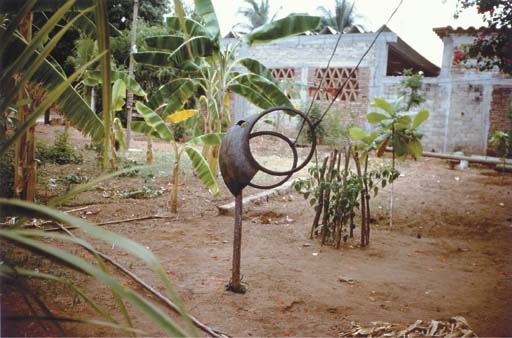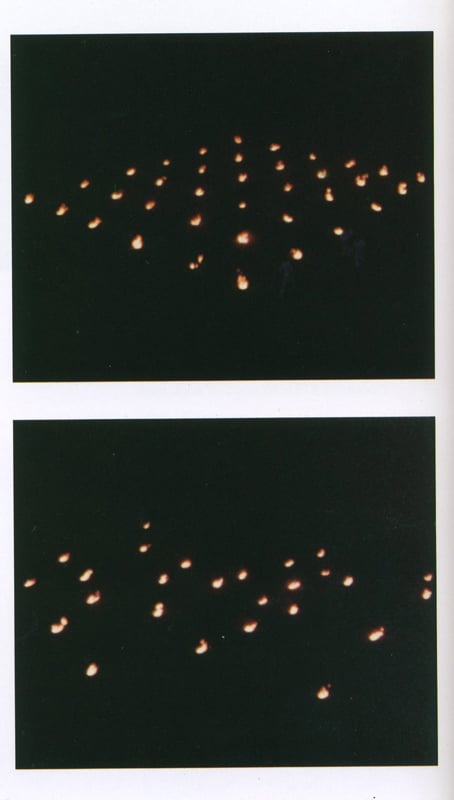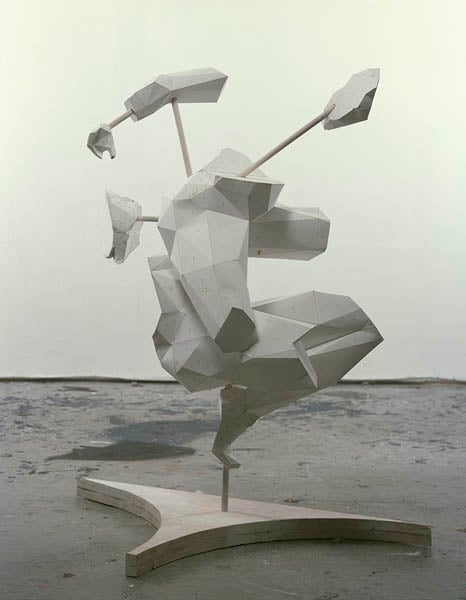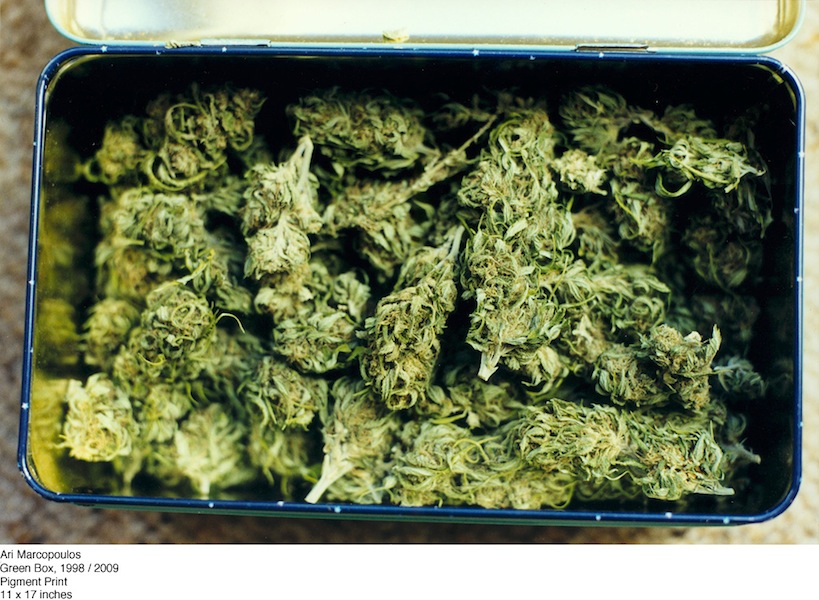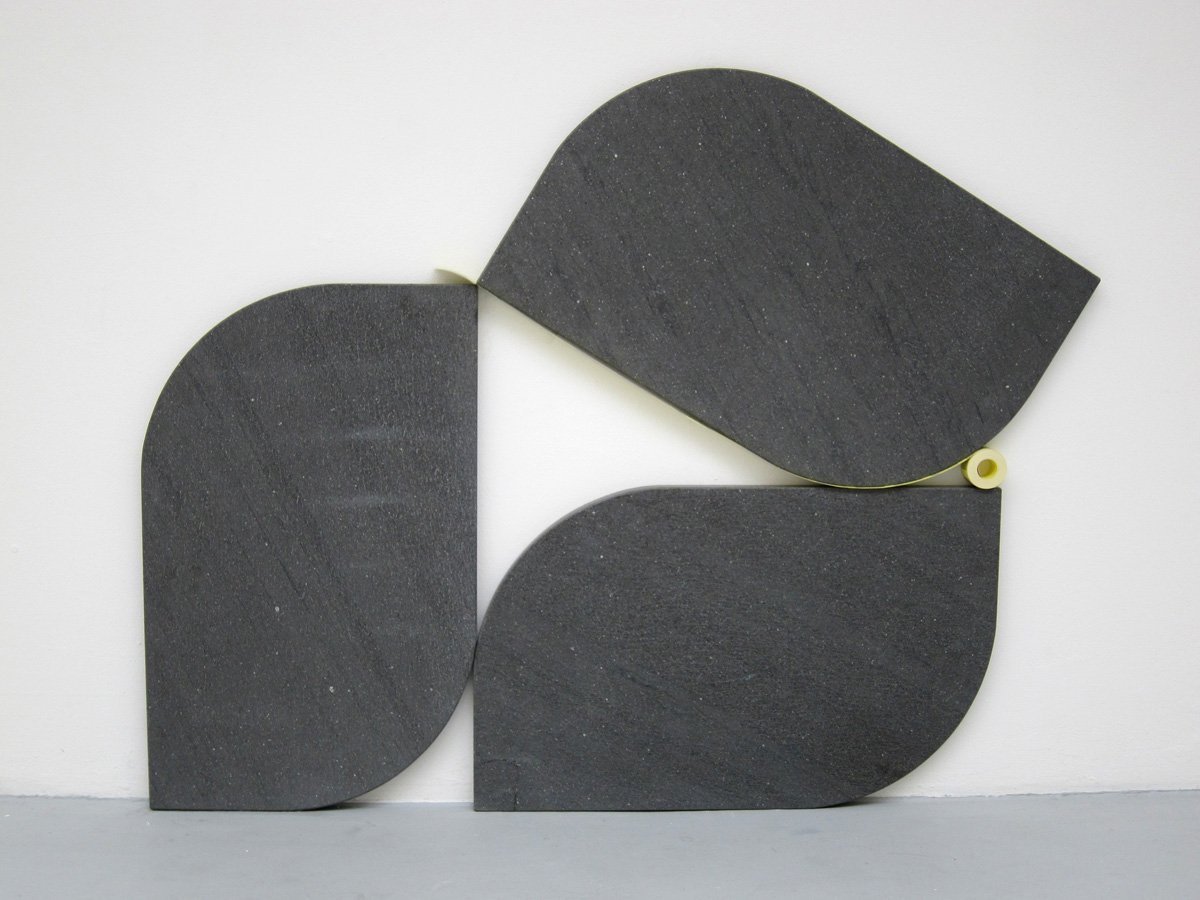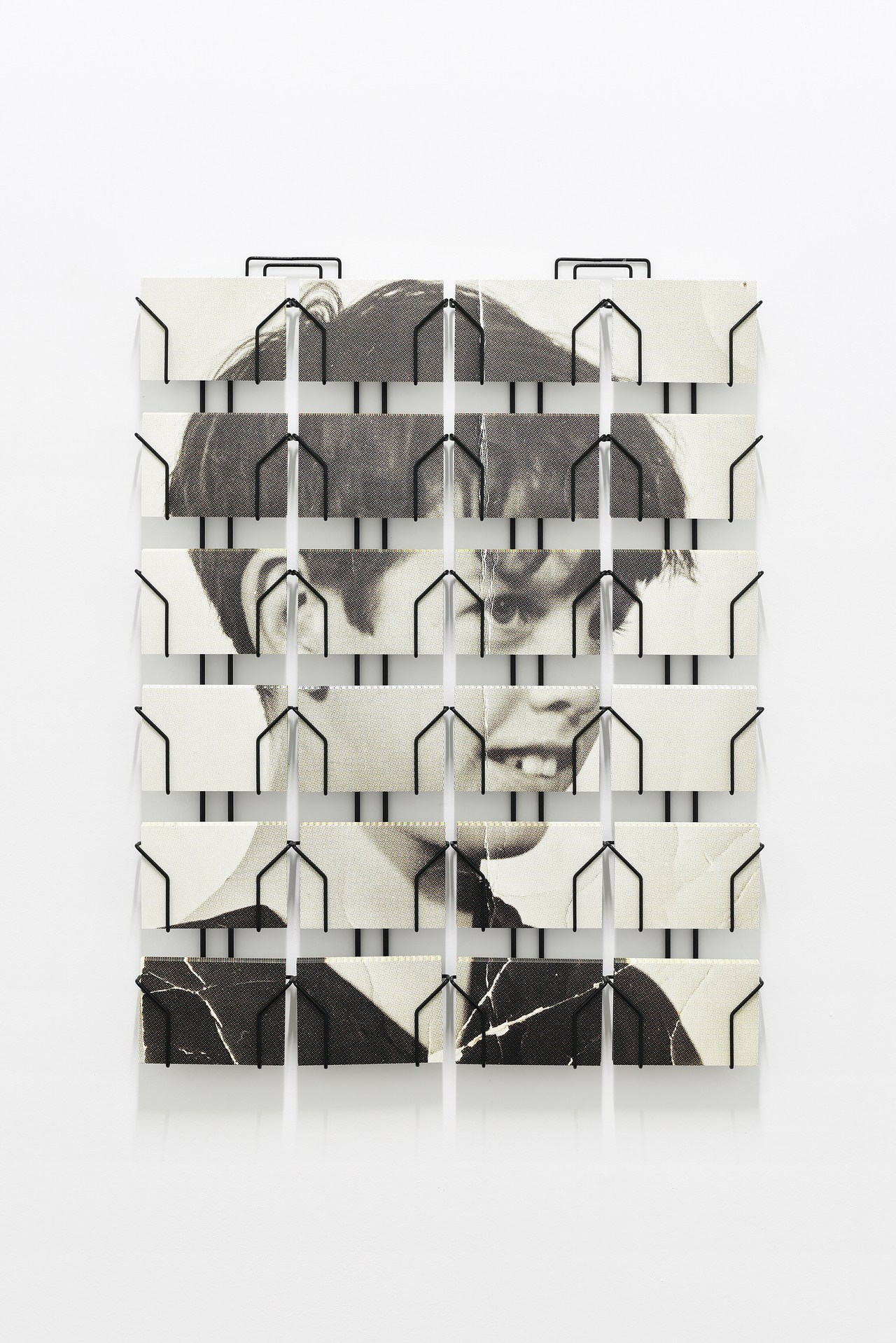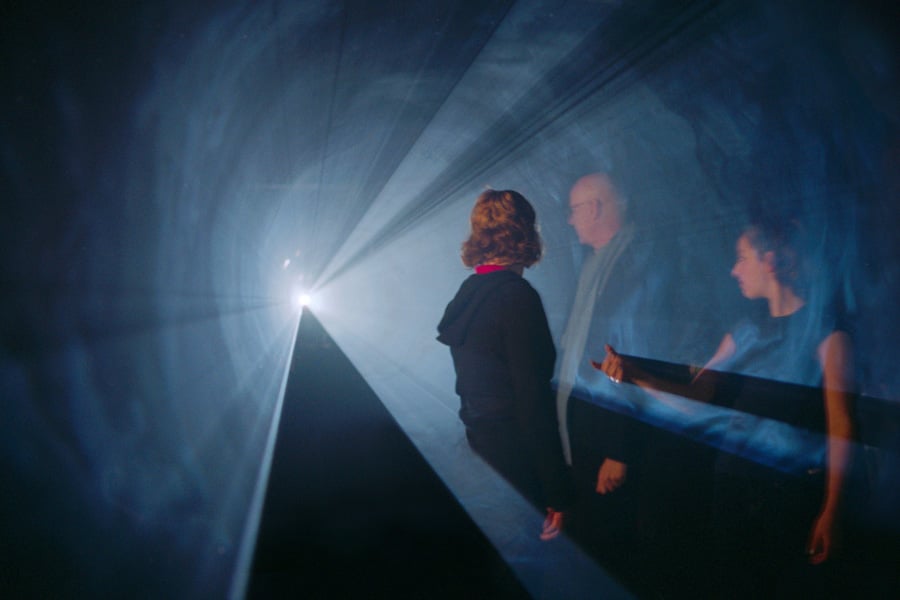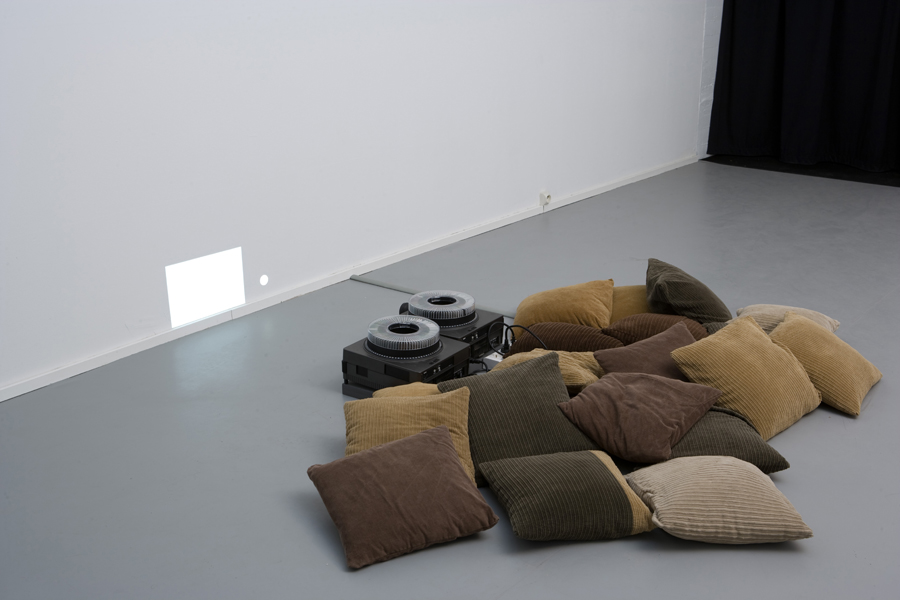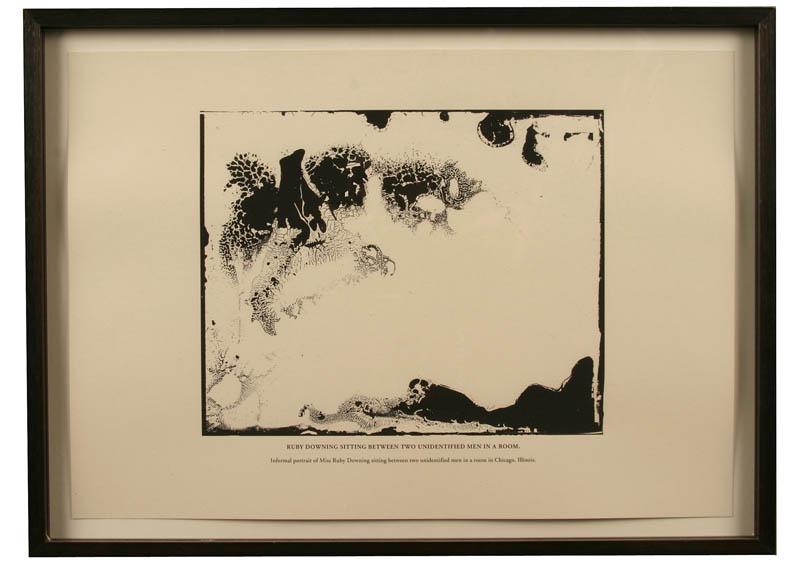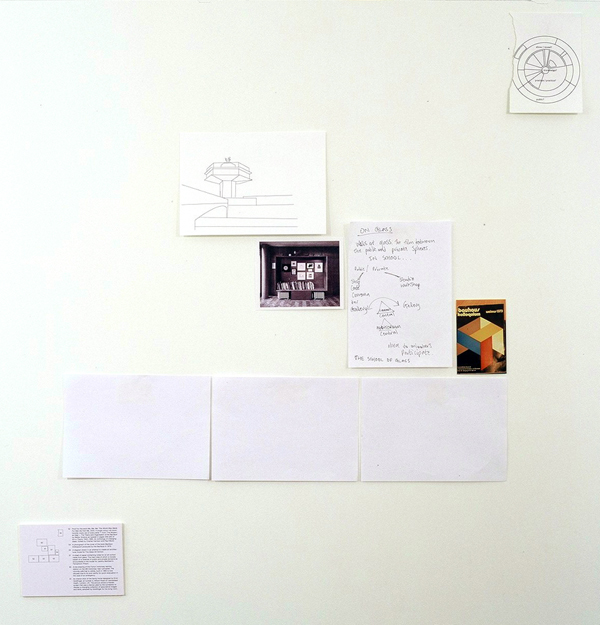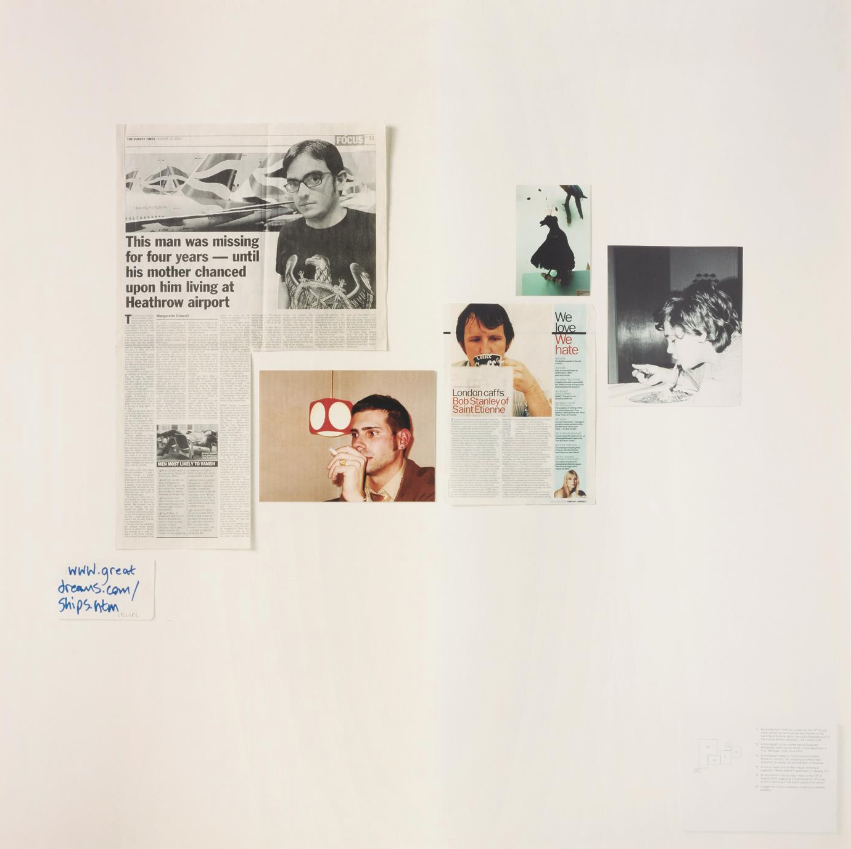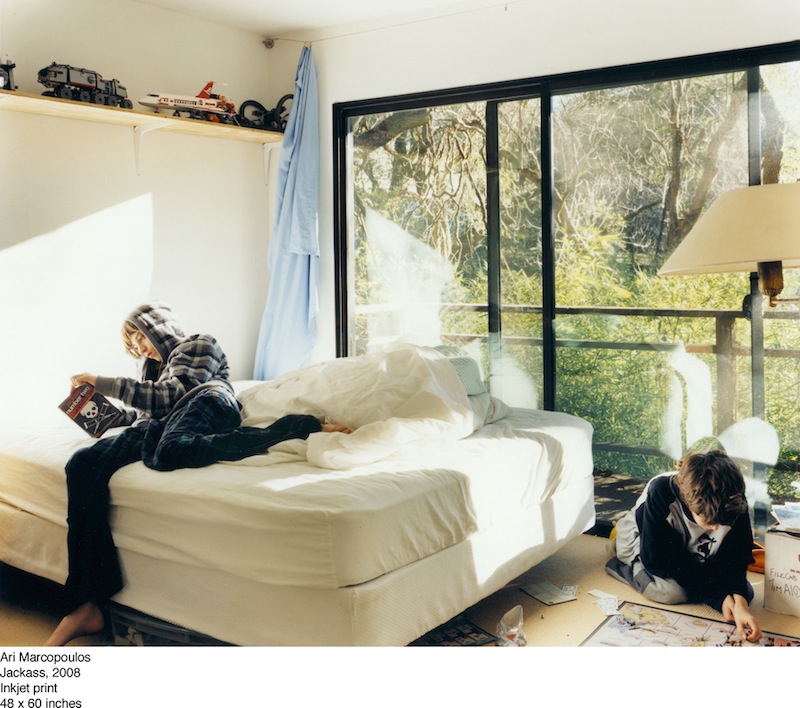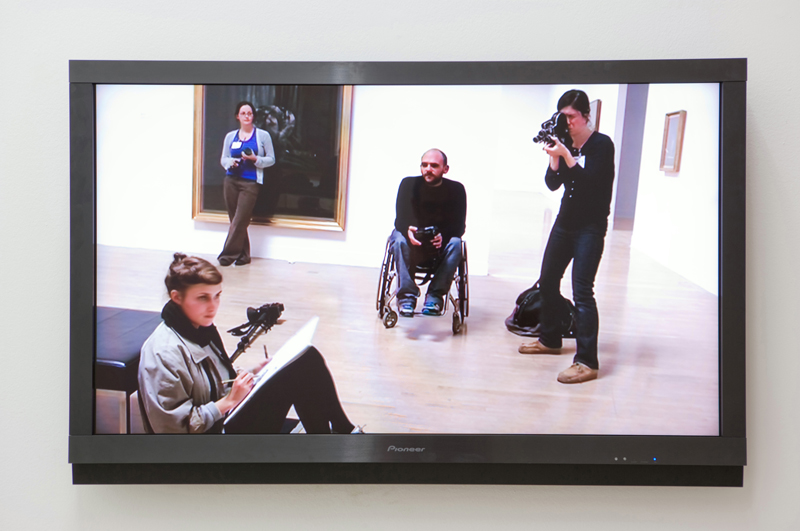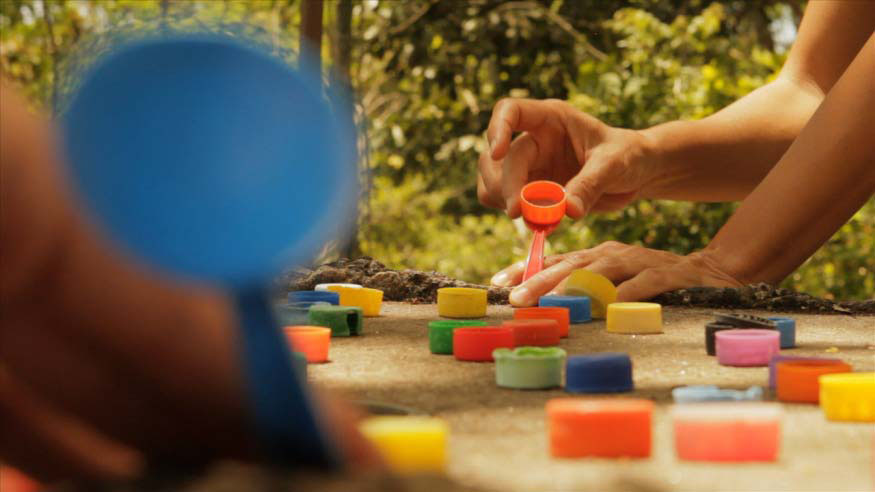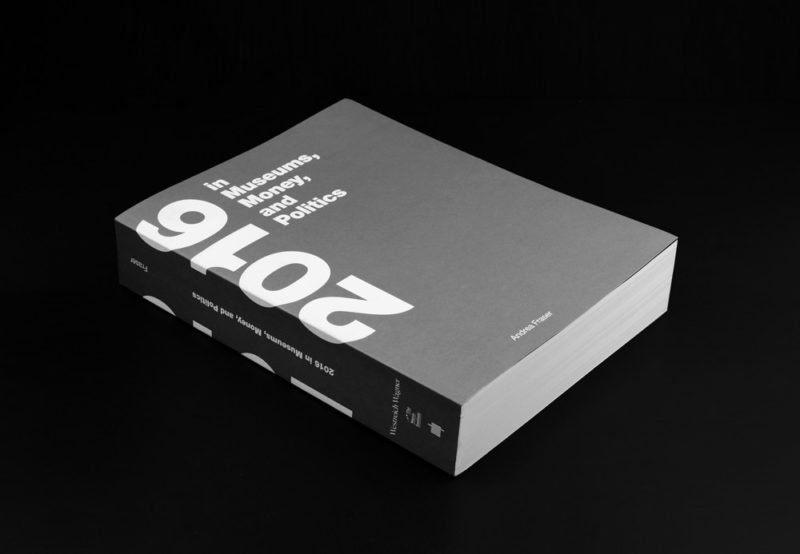
© » KADIST
Yang Guangnan
Itch explores the relationship between technology and daily human experience with a motorized arm that extends from within the gallery’s wall, moving up and down while holding a projector that shows a desperately scratching pair of hands.

© » KADIST
Yang Guangnan
In Action no. 1 Yang Guangnan reflects on the interiority and exteriority of human-technological experience with mechanical gestures that are semi-human and semi-machine. A hanged shirt mounted upon the artist’s machine rhythmically bounces and rotates in a way that suggests a skeletal interior.

© » KADIST
Gabriel Orozco
Gabriel Orozco often documents found situations in the natural or urban landscape. He travels armed with his camera and insightfully captures scenes of the everyday that other people might ignore. Perro en Tlalpan (Dog in Tlalpan, 1992) is a photograph of a dog regally perched under an industrial shelter in the borough of Tlalpan in Mexico City.
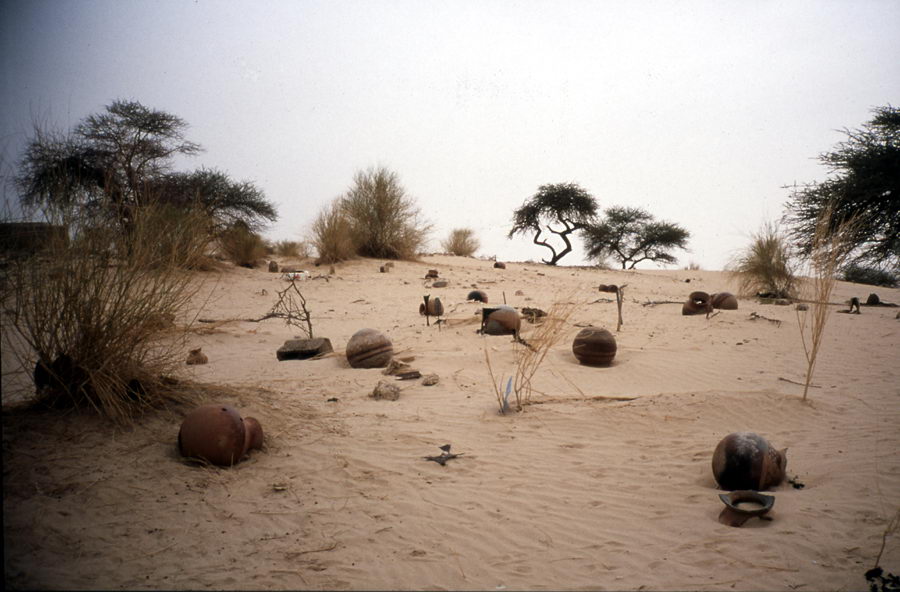
© » KADIST
Gabriel Orozco
Gabriel Orozco comments: “In the exhibition [Documenta 11, Kassel, 2002], I tried to connect with the photographs I took in Mali in July. I traveled to Mali for three weeks and took some photographs related to my work. They are very different, but there are links as the graveyard of Timbuktu, which I discovered during the trip.

© » KADIST
Gabriel Orozco
Charco portátil congelado (Frozen Portable Puddle, 1994) is a photographic record of an installation of the same name that Gabriel Orozco made at Witte de With Center for Contemporary Art in Rotterdam for the group exhibition WATT (1994). The artist arrived a week prior to the opening with no artwork to install, and created three spontaneous works from locally sourced materials. This one was made of white plastic record sleeves that Orozco arranged on the damp roof of the gallery.

© » KADIST
Jennifer Bornstein
Collectors’ Favorites is an episode of local cable program from the mid-1990s in which ordinary people were invited to present their personal collections—a concept that in many ways anticipates current reality TV shows and internet videos. When it comes her turn to “perform,” Bornstein displays mundane and disposable—but elaborately archived or framed—consumer objects such as coffee lids, plastic straws, candy wrappers, and product labels. Through the medium of public broadcasting, then, she makes visual the frequently overlooked but massive cultural penetration of advertising, and its proliferation of “throwaway culture” via images.

© » KADIST
Félix González-Torres
Behind the simplicity and beauty of this untitled photograph of a brilliantly-colored flowerbed by Félix González-Torres are two remarkable stories of love, loss, and resilience. As with most of his works, the photograph is untitled followed by a parenthesis that provides some context clues. In this case, an inscription on the reverse of the photograph reads: For Laura (Alice B. Toklas + Gertrude Stein Flower Bed in Paris).

© » KADIST
Lisa Oppenheim
Drawing & Print (Drawing & Print)
The Damaged series by Lisa Oppenheim takes a series of selected photographs from the Chicago Daily News (1902 – 1933) as its source material. For this project, Oppenheim procured the original glass negatives, which had been damaged over time, from the archives of this newspaper. She then printed the negatives as is, highlighting the multitude of physical flaws that had ‘spoiled’ the negatives.
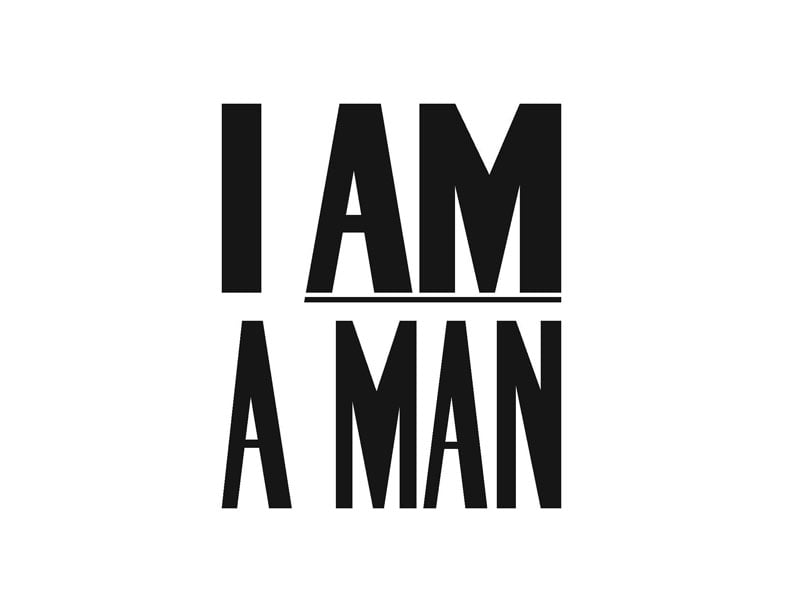
© » KADIST
Hank Willis Thomas
The image is borrowed from protests during Civil Rights where African Americans in the south would carry signs with the same message to assert their rights against segregation and racism. Historically, in countries such as the US and South Africa, the term “boy” was used as a pejorative and racist insult towards men of color, slaves in particular, signifying their alleged subservient status as being less than men. In response, Am I Not A Man And A Brother?

© » KADIST
Hank Willis Thomas
Drawing & Print (Drawing & Print)
Intentionally Left Blanc alludes to the technical process of its own (non)production; a procedure known as retro-reflective screen printing in which the image is only fully brought to life through its exposure to flash lighting. Using a found photograph depicting a passionate crowd of African Americans—their attitude suggesting the fervor of a civil-rights era audience— Intentionally Left Blanc reverts in its exposed, “positive” format to an image in which select faces are whitened out and erased, the exact inverse of the same view in its “negative” condition. This dialectic of light and dark re-emerges when we view the same faces again, only this time black and featureless, a scattering of disembodied heads amidst a sea of white.

© » KADIST
Kara Walker
In her masterpiece 8 Possible Beginnings or The Creation of African-America , Walker unravels just that, the story of struggle, oppression, escape and the complexities of power dynamics in the history following slave trade in America. Her use of contour and silhouette accentuate emotion with rigor, she reduces the narrative to black and white as gruesome acts of sex and violence address trauma, fear and suffering through a majestic play of shadow and light.

© » KADIST
Hank Willis Thomas
Bread and Roses takes its name from a phrase famously used on picket signs and immortalized by the poet James Oppenheim in 1911. “Bread for all, and Roses, too’—a slogan of the women in the West,” is Oppenheim’s opening line, alluding to the workers’ goal for wages and conditions that would allow them to do more than simply survive. Thomas’ painting includes several black, white, brown, yellow, and red raised fists—clenched and high in the air in the internationally recognized symbol of solidarity, resistance, and unity.

© » KADIST
Hank Willis Thomas
Drawing & Print (Drawing & Print)
Thomas’ lenticular text-based works require viewers to shift positions as they view them in order to fully absorb their content. Meaning, therefore, changes depending on one’s perspective—and in the case of Thomas’ installation, only emerges when one knows that there is always something hidden, always more to one of his works than immediately meets the eye. This lenticular print with text shifts as you walk in front of it from its title, “Black Imitates White” to the inverse, “White Imitates Black”(and some other possibilities in between) emphasizing that there are always at least two perspectives to the same scenario, and thereby encouraging us as viewers to consider them all together rather than trying to identify with any one subjectivity.

© » KADIST
Lisa Oppenheim
Drawing & Print (Drawing & Print)
The Damaged series by Lisa Oppenheim takes a series of selected photographs from the Chicago Daily News (1902 – 1933) as its source material. For this project, Oppenheim procured the original glass negatives, which had been damaged over time, from the archives of this newspaper. She then printed the negatives as is, highlighting the multitude of physical flaws that had ‘spoiled’ the negatives.

© » KADIST
An-My LE
The print Patient Admission, US Naval Hospital Ship Mercy, Vietnam (2010) features an Asian Buddhist monk and an American Navy Solider on board the Mercy ship –one of the two dedicated hospital ships of the United States Navy– sitting upright in their chairs and adopting the same posture. In the background, the steel pillars creates a division of space implying a separation the two men according to their geographic regions of origin or residence, their vocations, their ethnicities, and their attitudes toward war. Yet, the mirrored body language of the two characters also suggests their reconciliation into a dialogue perhaps characterized by the protagonists’ physical and spiritual conversation.

© » KADIST
Hank Willis Thomas
Like many of his other sculptural works, the source of I am the Greatest is actually a historical photograph of an identical button pin from the 1960s. I am the Greatest presents the famous quote by Mohammad Ali to think about his important presence in the African American community. In dialogue with the painting I am a Man, also in the Kadist collection, this assertion that begins the same way takes the line from the protest poster several steps further.

© » KADIST
Christine Sun Kim
Hand Palm Echo 1 is a digital animation based on Christine Sun Kim’s staircase mural at The Drawing Center in New York (10 March – 22 May, 2022). Sun produced this NFT from a still image of the animation that features a drawn notation of the sign “echo” in American Sign Language. Visually the black and white image depicts two side by side mounds, one labelled ‘Hand’ and the other labelled ‘Palm’.

© » KADIST
Bjorn Copeland
Sign #1 , Sign #2 , Sign #3 were included in “Found Object Assembly”, Copeland’s 2009 solo show at Jack Hanley Gallery, San Francisco. These rather austere collages were created by simply cutting and inverting the text from existing information signs. In Sign #2 , for example, the original image that presumably carried the message “NO RIDERS” was placed upside down.
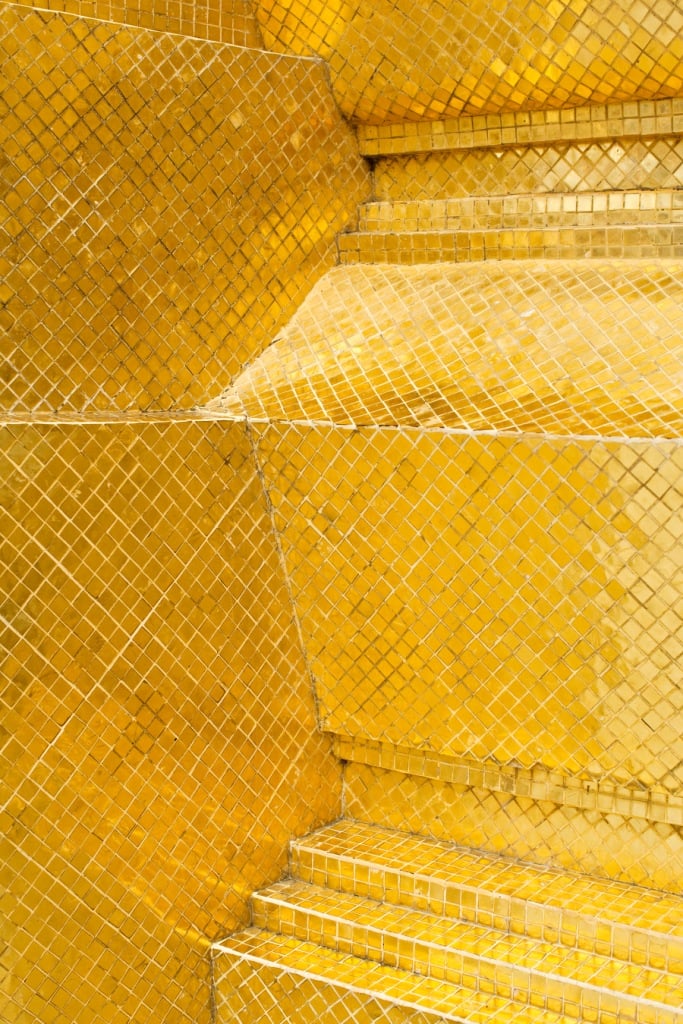
© » KADIST
Chris Wiley
Architectural details become abstracted renderings in Chris Wiley’s inkjet prints 11 and 20 (both 2012). In photographing seemingly mundane images of doorways and walls, Wiley collapses the viewer’s experience of inhabiting space by foregrounding features that we all too often miss in our built environment: the peeling white paint on a Corinthian column or the rusty studs on a blue door.

© » KADIST
Eleanor Antin
Comprised of fifty-one photographic postcards, Antin’s 100 Boots is an epic visual narrative in which 100 black rubber boots stand in for a fictional “hero” making a “trip” from California to New York City. Over two-and-a-half years, Antin photographed the boots against different backdrops across the U. S., and then turned the pictures into postcards, which she then mailed to approximately 1,000 people around the world. In conjunction with the boots’ “arrival” in New York City, the postcards were exhibited at the Museum of Modern Art.

© » KADIST
Gregory Crewdson
Forest Gathering N.2 is part of the series of photographs Beneath the Roses (2003-2005) where anonymous townscapes, forest clearings and broad, desolate streets are revealed as sites of mystery and wonder; similarly, ostensibly banal interiors become the staging grounds for strange human scenarios. These scenes are tangibly atmospheric, visually alluring and often deeply disquieting. Never anchored precisely in time or place, these and the other narratives of Beneath the Roses are rather located in the dystopic landscape of the anxious American imagination.

© » KADIST
Oded Hirsch
Oded Hirsch’s video work Nothing New (2012) utilizes seemingly absurdist tropes to raise more trenchant questions about communal action and collective identity in modern day Israel. In the video, a fallen parachutist hangs tangled by his own lines, suspended between two electrical towers in a surreally desolate landscape of overgrown fields in the Jordan Valley of Israel. A group of over a hundred men and women approach the towers, working with almost mechanic efficiency to free the parachutist from the power lines overhead.

© » KADIST
Valeska Soares
Relying on repetition and repurposed materials, Soares works to interrogate time—its measurement, its passing, and its meaning. With copper wire stretched out across the room like a clothesline, Valeska Soares’ La Ligne du Temps creates a timeline out of fluttering, old book pages. Read upon the pages of this delicately wrought installation are linguistic approaches to time and its phenomonologies.

© » KADIST
Glenn Ligon
Drawing & Print (Drawing & Print)
Glenn Ligon’s diptych, Condition Repor t is comprised of two side-by-side prints. Though simple, each contains a nested stack of historical and self-referential quotations. Both black-and-white prints depict a version of Ligon’s 1988 painting, Untitled (I Am A Man) , which declares the words of the parenthetical in blocky black letters.

© » KADIST
Hank Willis Thomas
South Africa Righteous Space by Hank Willis Thomas is concerned with history and identity, with the way race and ‘blackness’ has not only been informed but deliberately shaped and constructed by various forces – first through colonialism and slavery, and more recently through mass media and advertising – and reminds us of the financial and economic stakes that have always been involved in representations of race.
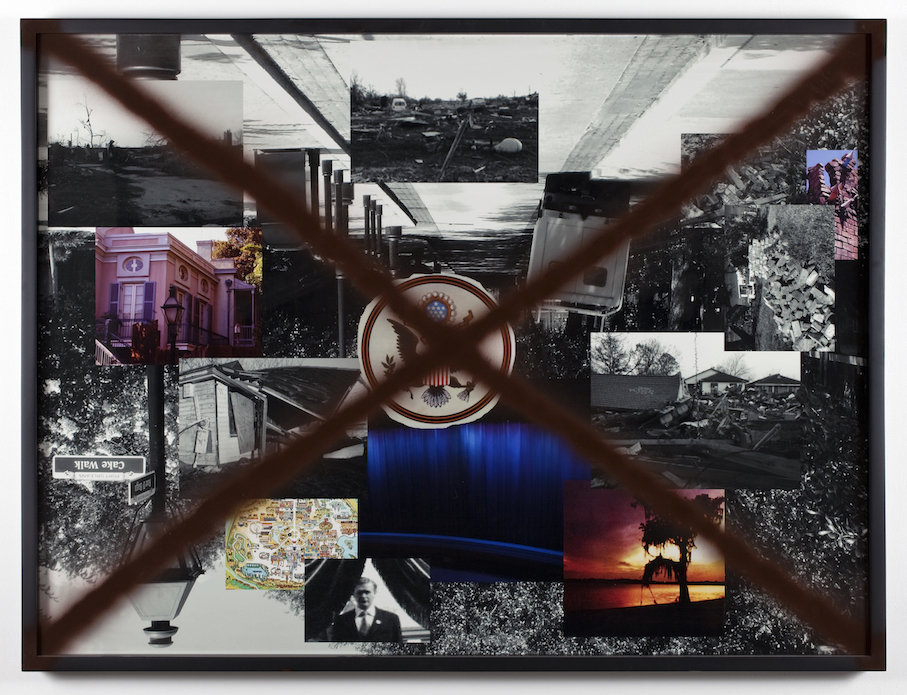
© » KADIST
Stephen G. Rhodes
For his series of digital collages Excerpt (Sealed)… Rhodes appropriated multiple images from mass media and then sprayed an X on top of their glass and frame. This visual seal refers to the disastrous aftermath of Hurricane Katrina in 2005 in which rescue workers spray painted the doors of the houses they searched giving the date, the team and the number of bodies found. Excerpt (Sealed) (Brown) is a multilayered collage with contradictory imagery—from New Orleans debris to the American eagle and a theater curtain.

© » KADIST
Juliana Huxtable
Herculine’s Prophecy by Juliana Huxtable features a kneeling demon-figure on what appears to be a screen-print, placed on a wooden table, which has then been photographed and digitally altered to appear like a book cover, with a title and subtitle across the top, and a poem written across the bottom. This composition is stuck to a metal plate by a series of button magnets, with interjecting phrases on them. The juxtaposition between the mysogynistic, almost puritan poetry that stripes across the bottom and the powerful crouching pose that the femme demon assumes inverts the hegemonic text , instead creating a space of alterity.
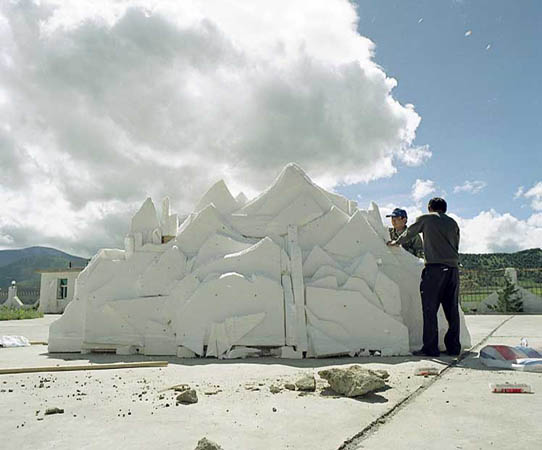
© » KADIST
Patty Chang
The video “Shangri-La” refers to the mythical city of James Hilton’s novel “Lost Horizon” written in 1933 and is exemplified in a film by Frank Capra which speaks of eternal youth in a city of happiness. In 1997, a small town in an agricultural region of central China near the Tibetan border was proclaimed as the place that inspired Shangri-la. Thereafter, a dozen other cities in the same area have claimed to be paradise on earth, prompting a marketing battle without mercy, raging on until the government’s intervention.

© » KADIST
Chris Wiley
Architectural details become abstracted renderings in Chris Wiley’s inkjet prints 11 and 20 (both 2012). In photographing seemingly mundane images of doorways and walls, Wiley collapses the viewer’s experience of inhabiting space by foregrounding features that we all too often miss in our built environment: the peeling white paint on a Corinthian column or the rusty studs on a blue door.
Hank Willis Thomas
- location: New York, New York
- year born: 1976
- gender: male
- nationality: American
- home town: Plainfield, New Jersey
Ryan Gander
- location: Chester, United Kingdom
- year born: 1976
- gender: male
- nationality: British
Pedro Reyes
- location: Mexico City, Mexico
- year born: 1972
- gender: male
- nationality: Mexican
- home town: Mexico City, Mexico
Mario Garcia Torres
- location: Mexico City, Mexico
- year born: 1975
- gender: male
- nationality: Mexican
- home town: Monclova, Mexico
Gabriel Orozco
- location: New York City, Paris
- location: Mexico
- year born: 1962
- gender: male
- nationality: Mexican
- home town: Jalapa, Mexico
Alexandre da Cunha
- location: London, United Kingdom
- year born: 1969
- gender: male
- nationality: Brazilian
- home town: Rio de Janeiro, Brazil
Lin Yilin
- location: Beijing & New York
- year born: 1964
- gender: male
- nationality: Chinese
- home town: Guangzhou, China
Martin Creed
- location: Wakefield, United Kingdom
- year born: 1968
- gender: male
- nationality: British
Anthony McCall
- location: London, United Kingdom
- year born: 1946
- gender: male
- nationality: British
Lisa Oppenheim
- location: New York, New York
- year born: 1975
- gender: female
- nationality: American
- home town: New York, New York
Toby Ziegler
- location: London, United Kingdom
- year born: 1972
- gender: male
- nationality: British
James Welling
- location: New York, New York; Los Angeles, California
- year born: 1951
- gender: male
- nationality: American
- home town: Hartford, Connecticut
Christine Sun Kim
- location: New York, New York
- year born: 1980
- gender: female
- nationality: American
- home town: Orange County, California
Tina Modotti
- location: Mexico City, Mexico
- year born: 1896
- gender: female
- nationality: Italian
- home town: Udine, Italy
Ari Marcopoulos
- location: New York, NY
- location: Sonoma, CA
- year born: 1957
- gender: male
- nationality: Dutch
- home town: Amsterdam, Netherlands
Yang Guangnan
- location: New York City, United States
- year born: 1986
- home town: Inner Mongolia, China
An-My LE
- location: New York, New York
- year born: 1960
- gender: female
- home town: Saigon, Vietnam
Chris Wiley
- location: New York, New York
- year born: 1981
- gender: male
- nationality: British
Charles Avery
- location: Oban, United Kingdom
- year born: 1973
- gender: male
- nationality: British
Cerith Wyn Evans
- location: London, United Kingdom
- year born: 1958
- gender: male
- nationality: British
- home town: Llanelli, United Kingdom
Kara Walker
- location: New York, New York
- year born: 1969
- gender: female
- nationality: American
- home town: Stockton, California
Amalia Pica
- location: London, United Kingdom
- year born: 1978
- gender: female
- nationality: Argentine
- home town: Neuquén, Argentina
Minerva Cuevas
- location: Mexico City, Mexico
- year born: 1975
- gender: female
- nationality: Mexican
- home town: Mexico City, Mexico
Patty Chang
- location: New York, New York
- year born: 1972
- gender: female
- nationality: American
- home town: San Francisco, California
Diego Rivera
- location: Mexico City, Mexico
- year born: 1886
- gender: male
- nationality: Mexican
- home town: Guanajuato, Mexico
Shahzia Sikander
- location: New York
- location: Texas
- year born: 1969
- gender: female
- nationality: Pakistani-American
- home town: Lahore, Pakistan
Trisha Donnelly
- location: New York, New York
- year born: 1974
- gender: male
- nationality: American
- home town: San Francisco, California
Gabriel Kuri
- location: Mexico City; Brussels, Belgium
- year born: 1970
- gender: male
- nationality: Mexican
- home town: Mexico City, Mexico
Oded Hirsch
- location: New York, New York
- year born: 1976
- gender: male
- nationality: Israeli
- home town: Kibbutz Afikim, Israel
Julieta Aranda
- location: Mexico City, Mexico
- year born: 1975
- gender: female
- nationality: Mexican
- home town: Mexico City, Mexico
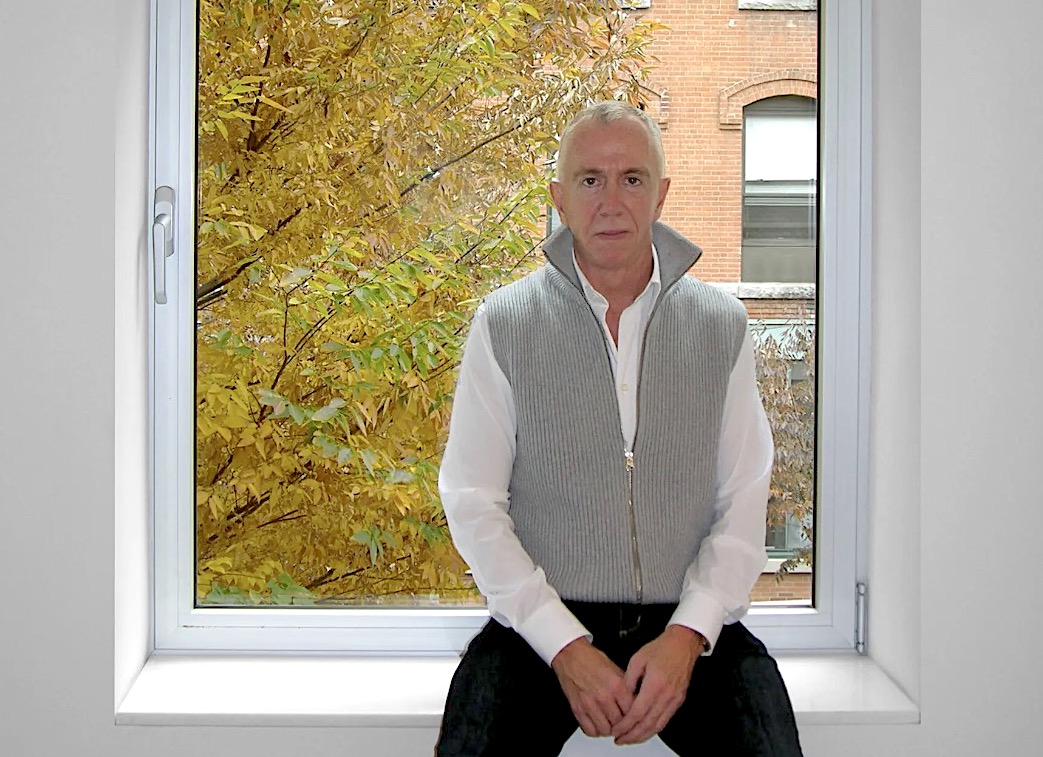
© » ARTLYST
about 3 months ago (01/17/2024)
Brent Sikkema, the Manhattan art dealer renowned for representing artists such as Jeffrey Gibson and Kara Walker found dead The post Brent Sikkema – Visionary Art Dealer Of Jeffrey Gibson And Kara Walker Murdered appeared first on Artlyst ....
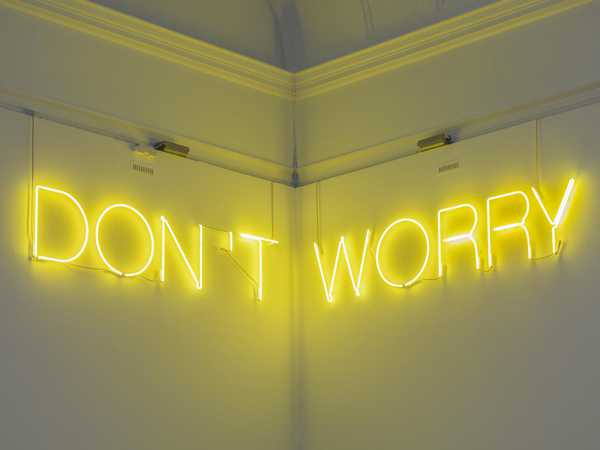
© » TATE EXHIBITIONS
about 3 months ago (01/06/2024)
Martin Creed | The Dick Institute Experience the work of one of this country’s most ingenious, audacious and surprising artists at the Dick Institute ARTIST ROOMS Martin Creed presents highlights from the British artist’s thirty-year career...

© » APERTURE
about 5 months ago (12/01/2023)
For the past two decades, An-My Lê has used photography to examine her personal history and the legacies of US military power, probing the tension between experience and storytelling....
-
1920-1929
Tina Modotti
1927Modotti’s Diego Rivera Mural: Billionaires Club; Ministry of Education, Mexico D...
-
1930-1939
Tina Modotti
1930The Italian photographer Tina Modotti is known for her documentation of the mural movement in Mexico...
-
1940-1949
Diego Rivera
1940In 1940 Rivera came to San Francisco for what would be his last mural project in the city, Pan-American Unity ...
-
1960-1969
Judy Chicago
1969Domes #1 represents a significant moment in Chicago’s career when her art began to change from a New York-influenced Abstract Expressionist style to one that reflected the pop-inflected art being made in Los Angeles...
-
1970-1979
Eleanor Antin
1973Comprised of fifty-one photographic postcards, Antin’s 100 Boots is an epic visual narrative in which 100 black rubber boots stand in for a fictional “hero” making a “trip” from California to New York City...
Anthony McCall
1973The film Line Describing a Cone was made in 1973 and it was projected for the first time at Fylkingen (Stockholm) on 30 August of the same year...
Anthony McCall
Drawing & Print
1974(Drawing & Print) This score is a graphic record of the detailed choreography of one of Anthony McCall’s Landscape for Fire performances...
-
1990-1999
Gabriel Orozco
1992Gabriel Orozco often documents found situations in the natural or urban landscape...
Félix González-Torres
1992Behind the simplicity and beauty of this untitled photograph of a brilliantly-colored flowerbed by Félix González-Torres are two remarkable stories of love, loss, and resilience...
Gabriel Orozco
1994Charco portátil congelado (Frozen Portable Puddle, 1994) is a photographic record of an installation of the same name that Gabriel Orozco made at Witte de With Center for Contemporary Art in Rotterdam for the group exhibition WATT (1994)...
Jennifer Bornstein
1994Collectors’ Favorites is an episode of local cable program from the mid-1990s in which ordinary people were invited to present their personal collections—a concept that in many ways anticipates current reality TV shows and internet videos...
Ari Marcopoulos
1998A photograph of a tin box full of marijuana simply titled Green Box, speaks to the constantly changing status of the substance–once taboo or illicit, now a symbol of a growing industry in Northern California...
-
2000-2009
Glenn Ligon
Drawing & Print
2000(Drawing & Print) Glenn Ligon’s diptych, Condition Repor t is comprised of two side-by-side prints...
Gabriel Orozco
2002Gabriel Orozco comments: “In the exhibition [Documenta 11, Kassel, 2002], I tried to connect with the photographs I took in Mali in July...
Matthew Buckingham
2002Matthew Buckingham presents a narrative directly connected with a highly symbolic site in the United States, the Mount Rushmore Memorial*...
Lisa Oppenheim
Drawing & Print
2003(Drawing & Print) The Damaged series by Lisa Oppenheim takes a series of selected photographs from the Chicago Daily News (1902 – 1933) as its source material...
Lisa Oppenheim
Drawing & Print
2003(Drawing & Print) The Damaged series by Lisa Oppenheim takes a series of selected photographs from the Chicago Daily News (1902 – 1933) as its source material...
Lisa Oppenheim
Drawing & Print
2003(Drawing & Print) The Damaged series by Lisa Oppenheim takes a series of selected photographs from the Chicago Daily News (1902 – 1933) as its source material...
Martin Creed
2003This photograph of Martin Creed himself was used as the invitation card for a fundraising auction of works on paper at Christie’s South Kensington in support of Camden Arts Centre’s first year in a refurbished building in 2005...
Martin Boyce
2003In the installation Our Love is like the Flowers, the Rain, the Sea and the Hours, Martin Boyce uses common elements from public gardens – trees, benches, trashbins– in a game which describes at once a social space and an abstract dream space...
Kelley Walker
2004The triptych Black Star Press is part of the series ‘The Black Star Press project’ initiated in 2004 by the American artist Kelley Walker...
Mario Garcia Torres
2004Mario Garcia Torres imagines cinematic devices to replay stories occasionally forgotten by Conceptual art...
Francis Alÿs
2004The Nightwatch , which is an ironic reference to the celebrated painting by Rembrandt, follows the course of a fox wandering among the celebrated collections of the National Portrait Gallery in London...
Kara Walker
2005In her masterpiece 8 Possible Beginnings or The Creation of African-America , Walker unravels just that, the story of struggle, oppression, escape and the complexities of power dynamics in the history following slave trade in America...
Gregory Crewdson
2005Forest Gathering N.2 is part of the series of photographs Beneath the Roses (2003-2005) where anonymous townscapes, forest clearings and broad, desolate streets are revealed as sites of mystery and wonder; similarly, ostensibly banal interiors become the staging grounds for strange human scenarios...
James Welling
2005#17 Pink is a photogram, a photographic image produced without the use of a camera...
Mario Garcia Torres
2005Mario Garcia Torres films a game of Charades among professional actors guessing the former North Korean dictator’s favorite Hollywood films...
Pedro Reyes
2005In Reyes’s words, “We should be able to extract the technological nutrients before we excrete our waste...
Alexandre da Cunha
2005His Deck Painting I recalls the simplistic stripes of conceptual artist Daniel Buren, or the minimal lines of twentieth century abstract painting, but is in reality a readymade, fashioned from repurposed fabric of deck chairs...
Alexandre da Cunha
2005Glaze (Savana) (2005) is an assemblage of found materials: a car wheel, a tire, and a wooden plinth of the type traditionally used to display sculpture...
Toby Ziegler
2005The Fifth Quarter might have taken its mysterious inspiration from the eponymous Stephen King story collated into the Nightmares & Dreamscapes collection...
James Welling
2006Welling employs simple materials like crumpled aluminum foil, wrinkled fabric and pastry dough and directly exposes them as photograms, playing with the image in the process of revealing it...
Minerva Cuevas
Drawing & Print
2006(Drawing & Print) During her research on primitive currencies and cultural cannibalism, Cuevas came across the Donald Duck comic book issue “The Stone Money Mystery,” where Donald goes on a quest to find missing museum objects...
Francis Alÿs
Drawing & Print
2006(Drawing & Print) This series of small drawings is executed with varying materials—pen, ink, colored pencil, charcoal, and masking tape—on architect’s tracing paper...
Hiraki Sawa
2006Hako (2006) depicts a mysterious and dystopic landscape where the world becomes flat: distance between different spaces, depth of field and three-dimensional perceptions are canceled...
Trisha Donnelly
2007Untitled is a black-and-white photograph of a wave just before it breaks as seen from the distance of an overlook...
Toby Ziegler
2007Wagon Wheel is a work with a fundamental dynamism that derives both from the rotating movement of the elements suspended on poles and the kicking of the legs of the figure...
Kate Gilmore
2008In the six-minute single-channel video Higher Horse , Kate Gilmore perches herself on top of a tall pile of plaster blocks, in front of a pink colored wall with vein-like streaks of red...
Ari Marcopoulos
2008In Jackass (2008) by Ari Marcopoulos, his two sons, Cairo and Ethan, are pictured relaxing in a disheveled bedroom in their Sonoma home...
Cerith Wyn Evans
2008Untitled (Perfect Lovers + 1) by Cerith Wyn Evans takes as its starting point Felix Gonzales-Torres’s seminal work Untitled (Perfect Lovers) , in which two clocks were synchronized and left to run without interference, the implication being that one would stop before the other...
Ian Breakwell
2008“BC/AD” (Before Cancer, After Diagnoses) is a video of photographs of the artist’s face dating from early childhood to the month before he died, accompanied by the last diary entries he wrote from April 2004 to July 2005 (entitled “50 Reasons for Getting Out of Bed”), from the period from when he lost his voice, thinking he had laryngitis, through the moment he was diagnosed with lung cancer and the subsequent treatment that was ultimately, ineffective...
Bjorn Copeland
2009Sign #1 , Sign #2 , Sign #3 were included in “Found Object Assembly”, Copeland’s 2009 solo show at Jack Hanley Gallery, San Francisco...
Fred Wilson
2009Fred Wilson’s flag paintings document the 20th century history of African people, indexing the period of liberation from colonialism...
Andrew Grassie
2009In 2008, Grassie was invited by the Whitechapel Gallery to document the transformation of some of its spaces...
-
2010-2019
An-My LE
2010The print Patient Admission, US Naval Hospital Ship Mercy, Vietnam (2010) features an Asian Buddhist monk and an American Navy Solider on board the Mercy ship –one of the two dedicated hospital ships of the United States Navy– sitting upright in their chairs and adopting the same posture...
Stephen G. Rhodes
2010For his series of digital collages Excerpt (Sealed)… Rhodes appropriated multiple images from mass media and then sprayed an X on top of their glass and frame...
Shahzia Sikander
2010The Last Post was inspired by Sikander’s ongoing interest in the colonial history of the sub-continent and the British opium trade with China...
Gabriel Kuri
2010Gabriel Kuri has created a series of works in which he juxtaposes perennial and ephemeral materials...
Mario Garcia Torres
2010In Up All Night, Waiting for the Chelsea Hotel Magic to Spark My Creativity Mario García Torres constructs and documents a hypothetical scene, situating himself within a lineage of artists and creatives that used to congregate at the historic hotel...
Tomoko Yoneda
2010Yoneda’s Japanese House (2010) series of photographs depicts buildings constructed in Taiwan during the period of Japanese occupation, between 1895 and 1945...
Alexandre da Cunha
2010In Laissez-Faire (Rainbow Flag) da Cunha has turned a beach towel into both a painting and a flag...
Yang Guangnan
2011Itch explores the relationship between technology and daily human experience with a motorized arm that extends from within the gallery’s wall, moving up and down while holding a projector that shows a desperately scratching pair of hands....
Charles Avery
Drawing & Print
2011(Drawing & Print) Charles Avery has been constructing a narrative in his work since 2004...
Alexandre da Cunha
2011The series West (Flag 1), West (Flag 3), and West (Flag 6) continues da Cunha’s ongoing exploration of the form’s various vertical, horizontal, and diagonal stripes...
Hank Willis Thomas
Drawing & Print
2012(Drawing & Print) Intentionally Left Blanc alludes to the technical process of its own (non)production; a procedure known as retro-reflective screen printing in which the image is only fully brought to life through its exposure to flash lighting...
Hank Willis Thomas
2012Bread and Roses takes its name from a phrase famously used on picket signs and immortalized by the poet James Oppenheim in 1911...
Hank Willis Thomas
Drawing & Print
2012(Drawing & Print) Thomas’ lenticular text-based works require viewers to shift positions as they view them in order to fully absorb their content...
Hank Willis Thomas
2012Like many of his other sculptural works, the source of I am the Greatest is actually a historical photograph of an identical button pin from the 1960s...
Chris Wiley
2012Architectural details become abstracted renderings in Chris Wiley’s inkjet prints 11 and 20 (both 2012)...
Oded Hirsch
2012Oded Hirsch’s video work Nothing New (2012) utilizes seemingly absurdist tropes to raise more trenchant questions about communal action and collective identity in modern day Israel...
Valeska Soares
2012Relying on repetition and repurposed materials, Soares works to interrogate time—its measurement, its passing, and its meaning...
Chris Wiley
2012Architectural details become abstracted renderings in Chris Wiley’s inkjet prints 11 and 20 (both 2012)...
Donna Conlon and Jonathan Harker
2012In Tapitapultas (2012), Donna Conlon and Jonathan Harker comment on mass consumerism and pollution by way of a game they invented...
Pedro Reyes
2012Pedro Reyes’s Los Mutantes ( Mutants , 2012) is composed of 170 plates that combine characters from ancient and modern mythologies...
Ryan Gander
2012Epiphany…learnt through hardship is composed of a bronze sculpture depicting the model of the little dancer of Degas, in the pose of a female nude photographed by Edward Weston (Nude, 1936) accompanied by a blue cube...
Charles Avery
Drawing & Print
2012(Drawing & Print) Since 2005, Charles Avery has devoted his practice to the perpetual description of a fictional island...
Jeremy Deller
2012Beyond the White Walls , with a commentary written and spoken by Jeremy Deller, is often wryly amusing...
Hank Willis Thomas
2013The image is borrowed from protests during Civil Rights where African Americans in the south would carry signs with the same message to assert their rights against segregation and racism...
Regina José Galindo
2013In 2012, former Guatemalan President José Efran Ros Montt was charged with genocide and crimes against humanity; Regina José Galindo’s video Tierra is a chilling reimagining of the atrocities recounted during his trial...
Amalia Pica
2013Memorial for intersections #2 (2013) is a minimalist, black metallic structure that contains the brightly colored translucent circles, triangles, rectangles, and squares that originally were presented in Pica’s performance work A ? B ? C (2013)...
Hank Willis Thomas
2014South Africa Righteous Space by Hank Willis Thomas is concerned with history and identity, with the way race and ‘blackness’ has not only been informed but deliberately shaped and constructed by various forces – first through colonialism and slavery, and more recently through mass media and advertising – and reminds us of the financial and economic stakes that have always been involved in representations of race....
Hank Willis Thomas
Drawing & Print
2014(Drawing & Print) Shot in black and white and printed on a glittery carborundum surface, Black Hands, White Cotton both confronts and abstracts the subject of its title...
Ximena Garrido Lecca
2014Destilaciones ( Distillations , 2014) is an installation composed of a group of ceramic pots, presented on the floor and within a steel structure...
Julieta Aranda
2016The video Swimming in rivers of Glue is composed of various images of nature, exploring the themes of exploration of space and its colonization...
Juliana Huxtable
2017Herculine’s Prophecy by Juliana Huxtable features a kneeling demon-figure on what appears to be a screen-print, placed on a wooden table, which has then been photographed and digitally altered to appear like a book cover, with a title and subtitle across the top, and a poem written across the bottom...
Matt Mullican
Drawing & Print
2018(Drawing & Print) Mullican’s Stick Figure Drawings depict characters reduced to their most basic graphic representation...
Xaviera Simmons
2019Xaviera Simmons often employs her own body and collected materials in the service of her photographs and performances...
Rosalind Nashashibi
2019Rosalind Nashashibi’s paintings incorporate motifs drawn from her day-to-day environment, often reworked with multiple variations...
-
2020-2029
Andrea Fraser
Drawing & Print
2020(Drawing & Print) The year 2016 is organized like a telephone book; the data corresponding to the contributions are classified in alphabetical order by the name of the donor...
Christine Sun Kim
2022Hand Palm Echo 1 is a digital animation based on Christine Sun Kim’s staircase mural at The Drawing Center in New York (10 March – 22 May, 2022)...
